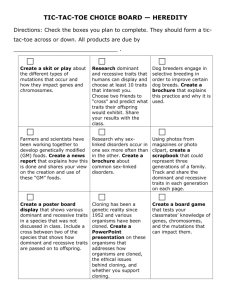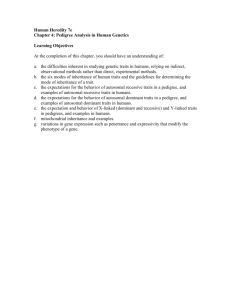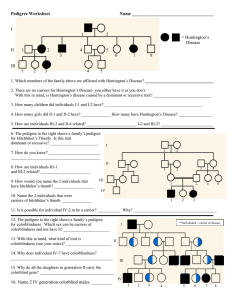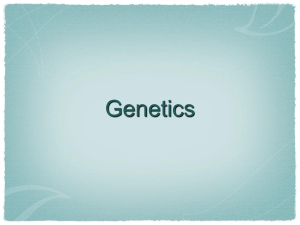Chapter 12 1.19
advertisement
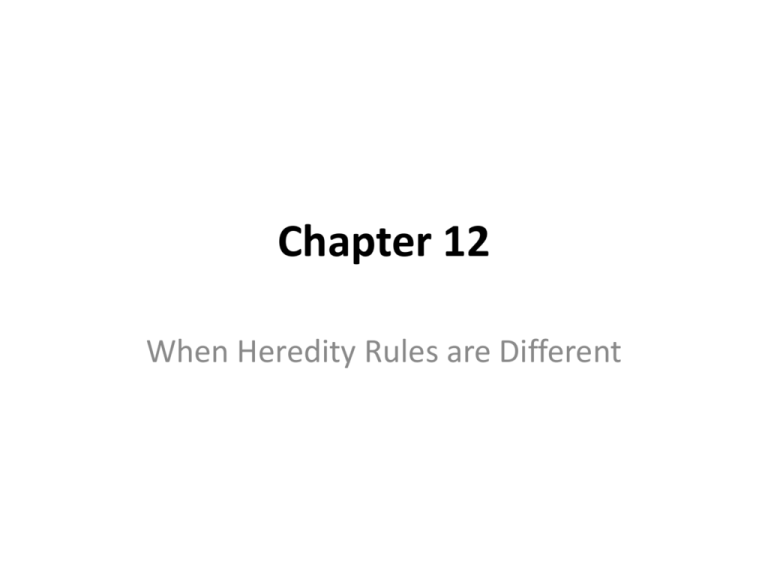
Chapter 12 When Heredity Rules are Different Complex Patterns of Heredity • Most traits are not simply dominant or recessive • Incomplete dominance: when the phenotype of the heterozygous individual is in between those of the two homozygotes (a mixture) • Red flower color (RR) • White flower color (rr) • Pink colored flowers (Rr) • Codominace: when the alleles of both homozygotes (BB or WW) are expressed equally in the heterozygous individual – black chicken (BB) – white chicken (WW) – offspring will be checkered • Sex-linked traits: traits controlled by genes located on sex chromosomes – Sex chromosomes: 23rd pair in humans that determine a person’s sex (X or Y) Females are XX, males are XY • X-linked disorders: generally passed on from mother to son – is found on the X chromosome • Example: Down’s Syndrome (trisomy 21) • colorblindness • Y-linked disorders: only passed on from father to son • Examples: excessive hair growth of the ears & male infertility Colorblindness Tests Normal color: Colorblind sees: yellow square & yellow square faint brown circle Colorblind sees: the number 17 Normal Color sees: the number 15 Test Name: Ishihara Test • Polygenic inheritance: when one trait is controlled by many genes. • Examples: height, eye color, skin color, & blood type Changes in Chromosomal Numbers • Humans have 23 pairs of chromosomes • (46 total); more or less = disorder • Autosomes: a non-sex chromosome – Known as chromosomes 1-22 8 Environmental Factors That Can Also Influence Gene Expression • 1. temperature • 5. infectious agents • 2. light • 6. hormones • 3. nutrition • 7. structural differences • 4. chemicals • 8. age *** know examples*** Chapter 12: Patterns of Heredity & Human Genetics Mendelian Inheritance of Human Traits Making a Pedigree • When genetic inheritance is represented by a picture, this is called a pedigree. – It is a diagram made of symbols that identify three things: • 1. Male or female • 2. Individuals affected by the trait being studied • 3. Family relationships Symbols of a pedigree: ***need to know*** Carrier – heterozygous individual Constructing and Reading a pedigree I. 1 2 II. 1 2 3 4 5 III. 1 2 3 4 5 ***Roman Numerals (I, II, III) refers to the generations.*** *Arabic numbers refers to individuals. (1, 2, 3, 4, 5, …) 6 Reading the pedigree… I. 1 2 II. 1 2 3 4 5 6 7 III. 1 2 3 4 How many generations are there? How many children did II-1 have? II-7? How are III-5 and III-2 related? Who is III-2 in reference to I-2? 5 Simple Recessive Heredity • Most genetic disorders are caused by recessive alleles. This means the disorder is inherited when both parents have a recessive allele. • Ex: Cystic Fibrosis (CF), Tay-Sachs Disease Pedigree for Cystic Fibrosis Pedigree for Tay-Sachs Simple Dominant Heredity • Dominant disorders: Only one dominant allele has to be inherited from either parent. • Simple Dominant Traits – 1. cleft chin – 2. unattached earlobes – 3. almond shaped eyes – EX: Huntington’s Disease Is it Dominant or Recessive… I. 1 2 3 4 II. 1 2 4 3 5 6 III. 1 2 3 Dominant, only one parent has the disorder. Is it Dominant or Recessive… I. 1 2 3 4 II. 1 2 4 3 5 6 III. 1 2 3 Recessive, neither parent has the disorder. Both are heterozygous.




